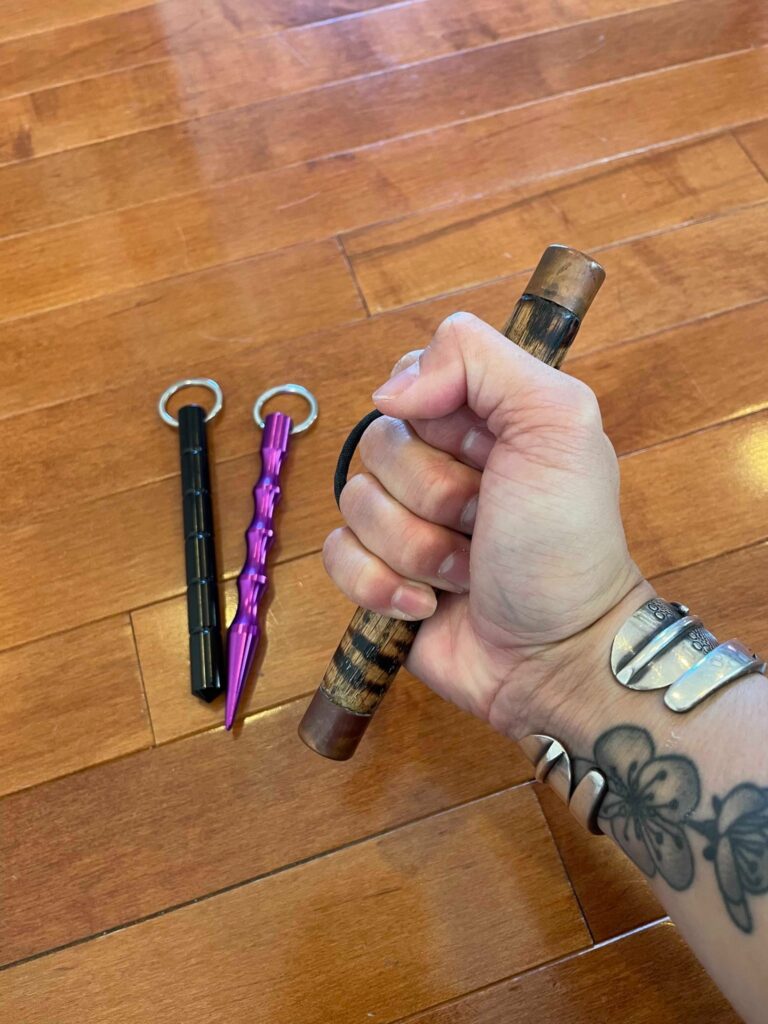
Since the kubaton episode of my series with InRange TV came out last week, there’s been some doubt about whether a simple stick can really be an effective force multiplier when hitting someone with the end of it. To understand why it can be, let’s talk about this style of force multipliers generally and how and why they work (and don’t work).
The short answer is physics: concentrating how hard you hit someone – the force that you’re using – into a smaller surface area makes the pressure of that strike higher. In other words, pounds per square inch is a thing. Think about the difference between an open-handed slap and a closed-fist punch, for instance. Even with the exact same amount of energy driving the hand, that punch is going to hurt someone more. With a kubaton protruding from the striking surface of your hand, like in the hammer fist I demonstrated on video and show with the koppo stick here, everything you can put into that punch is concentrated into the tiny area that is the end of the kubaton. Even if it doesn’t have a pointy end, poking someone hard with a stick can certainly cause pain, bruising, and even puncture wounds. Sounds great, right? Not so fast…
There are a number of caveats to effectiveness, and they’re important to understand so that you can decide if a striking tool is a good addition to your self-defense toolkit.
First, any sort of tool that you use to make your punches harder only work when you are within arm’s reach of your opponent. There are a lot of downsides to that, not the least of which is that not only can you reach out and touch them, they can do the same to you. No matter how tough we think we are, and no matter how good a fighter we might be, the other guy is going to get a vote here and since we’re talking about self-defense, odds are pretty good that they’re trying hard to hurt you back. Relying on a weapon that requires you to get up close before you can use it opens you up to a lot more risk than if you are able to use other weapons or techniques that can allow you to maintain real distance from someone who is trying to grab and hit you too. If they’re successful, they can stop or hurt you even if you manage to get a few licks in.
You also can’t just blindly flail at your attacker, and count on the extra force generated by the tool to make up the difference. While targeting specific points isn’t necessary, some places are indeed better than others when it comes to potentially being able to disable or discourage the other person. It’s not that you can count on poking out an eye or hitting a nerve cluster to cause instant incapacitation, but you do need to try to hit at areas where bone and blood are closer to the surface and less hidden behind fat and muscle or you will be less likely to cause the kind of pain or actual injury that will really make someone pause or end an attack. This, by the way, is why a pointy kubaton in particular has the possibility of being considered lethal force, when it’s driven through the skin and into the neck, lungs, and similar structures. Of course, some amount of power behind the tool is important too, because a force multiplier can’t turn a very light strike into a very heavy one. There’s a limit to how much multiplication can occur, which is why I recommend the hammer fist as it is easier to generate more power with it than other kinds of strikes.
Being able to throw a punch where you want it to land in practice or against a cooperative training partner doesn’t mean you’ll be able to do it when the other guy really doesn’t want to get hit. They can – and will! – twist and dodge and try to catch or block your hands. If you’re right up in a tangle with them, they will also be too close for you to use the rest of your body to help put more power into your fist, so that you won’t be able to hit as hard as you otherwise might. Not being able to wind up your arm or use your hips and legs will make it more challenging for you to strike with enough force that multiplying it will help you. It’s why you see boxers maintain a certain amount of distance when they fight, because standard punches don’t work as well for most people when you’re way up close. There are other ways to hit someone that work better there, but outside the scope of using tools like kubatons to make strikes more effective.
Even if you can survive or not be brutally injured by an attacker who can physically reach you, and even if you can hit them properly, there’s still another problem with relying on a striking tool: you must be able to get it into your hand, keep it in your hand, and not have it hurt you as much as or more than it hurts the other guy. I talked in the video about how a kubaton is useful because women especially can often get away with holding on to one in places where they might expect danger. That’s not always going to be the case, though, and if not, wishing mightily for the tool to appear in your hand when you need it won’t get it there. Even if you do have it when you need it, you need to hang on to it in the midst of someone fighting back and against the resistance of you hitting with it. The texturing on most kubatons will help a little, but they can still pop through your fist as they meet flesh or bone, and your fist may open as you panic or as your hand and arm are impacted. The loop on a koppo stick makes it harder to drop, although you then have to think about what happens when the tool tries to go somewhere and your fingers don’t want to follow, especially with a stick that isn’t well-designed or properly made. It’s related to, but not quite, the problem I’ve pointed out with “cat” keychains and making your keys stick out from between your fingers: certain tools can hurt you too, without needing to be taken away and used against you. Less of an issue with a straight kubaton, but an issue worth considering with variations and related tools.
Still a worthwhile tool for self-defense? Well, maybe. If it’s what you’ve got, it’s certainly better than nothing and it has the potential to be actually effective. As a first choice, though? I’m continuing to recommend other options.




